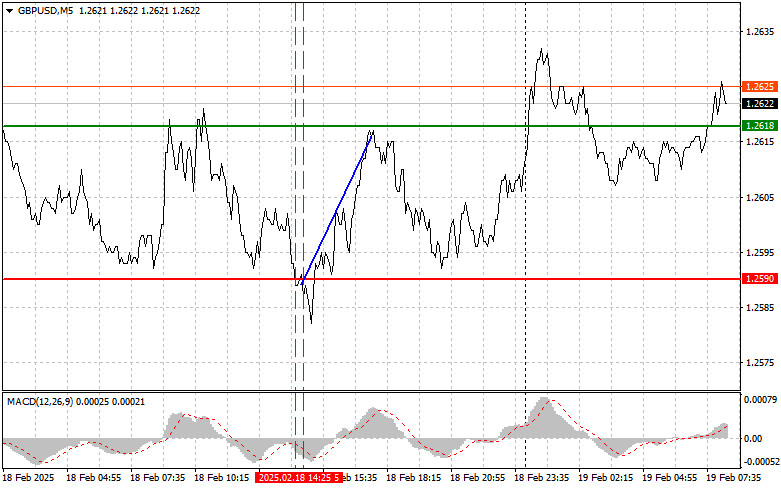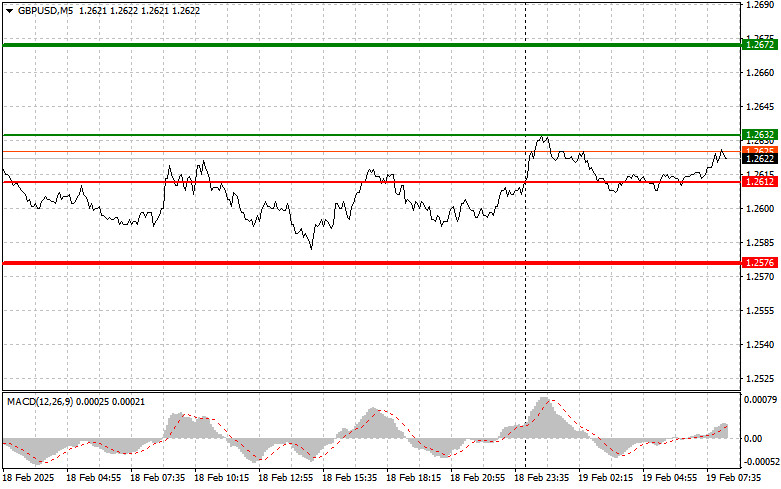Analysis of Trades and Trading Tips for the British Pound
The price level of 1.2590 was tested when the MACD indicator dropped significantly below the zero mark, limiting the downside potential for the pair. Because of this, I decided against selling the pound. Shortly after, there was another test of 1.2590, with the MACD in the oversold zone, which led to the execution of Buy Scenario #2. This resulted in a gain of over 25 pips.
Optimism surrounding the British currency may be driven by expectations of further monetary easing by the Bank of England. However, inflation in the UK remains volatile, and signs of economic stagnation suggest that the central bank may continue with planned rate cuts. This creates an unappealing outlook for investors, indicating that the pound's growth will likely be limited.
Additionally, the risk of an escalating trade war between the U.S. and other countries could negatively impact the global economy, which would, in turn, affect the UK. In such a situation, ignoring negative news could lead to significant losses for those buying the pound.
Today, important economic data will be released, potentially influencing Bank of England policy decisions. The UK Consumer Price Index (CPI) and Core CPI will set the market's direction. If inflation rises more than expected, the pound may extend its upward trend, as this would weaken expectations of further rate cuts in the UK. Conversely, if the data indicates slower inflation, the pressure on the BoE to cut rates will increase, likely leading to pound depreciation.
Traders will closely monitor the difference between actual data and forecasts, as this discrepancy will determine the currency's short-term direction. Additionally, comments from BoE officials after the data release will be crucial, as they could adjust market expectations regarding future monetary policy.
I will focus primarily on implementing Scenario #1 and Scenario #2 for intraday strategy.
Buy Signal
Scenario #1: Today, I plan to buy the pound upon reaching 1.2632 (green line on the chart) with a target of 1.2672 (thicker green line on the chart). At 1.2672, I plan to exit purchases and open sell positions in the opposite direction, expecting a 30-35 pip movement in the opposite direction from the entry level. The pound's continued growth will depend on sustained bullish momentum. Important: Before buying, ensure that the MACD indicator is above the zero mark and just starting to rise.
Scenario #2: I also plan to buy the pound today if two consecutive tests of the 1.2612 level occur while the MACD indicator is in the oversold zone. This will limit the pair's downside potential and trigger a reversal to the upside. The expected price targets are 1.2632 and 1.2672.
Sell Signal
Scenario #1: I plan to sell the pound after a break below 1.2612 (red line on the chart), which will likely lead to a rapid decline. The key downside target is 1.2576, where I plan to exit the market and immediately buy in the opposite direction, expecting a 20-25 pip reversal. Selling the pound is preferable at higher levels. Important: Before selling, ensure that the MACD indicator is below the zero mark and just starting to decline.
Scenario #2: I also plan to sell the pound today if two consecutive tests of the 1.2632 level occur while the MACD indicator is in the overbought zone. This will limit the pair's upside potential and trigger a reversal downward. The expected price targets are 1.2612 and 1.2576.
What's on the Chart:
- The thin green line represents the entry price where the trading instrument can be bought.The thick green line indicates the expected price level where a Take Profit order can be placed, or profits can be manually secured, as further price growth above this level is unlikely.The thin red line represents the entry price where the trading instrument can be sold.The thick red line indicates the expected price level where a Take Profit order can be placed, or profits can be manually secured, as further price decline below this level is unlikely.The MACD indicator should be used to assess overbought and oversold zones when entering the market.
Important Notes:
- Beginner Forex traders should exercise extreme caution when making market entry decisions. It is advisable to stay out of the market before the release of important fundamental reports to avoid exposure to sharp price fluctuations. If you choose to trade during news releases, always use stop-loss orders to minimize potential losses. Trading without stop-loss orders can quickly wipe out your entire deposit, especially if you neglect money management principles and trade with high volumes.
- Remember, successful trading requires a well-defined trading plan, similar to the one outlined above. Making impulsive trading decisions based on the current market situation is a losing strategy for intraday traders.













